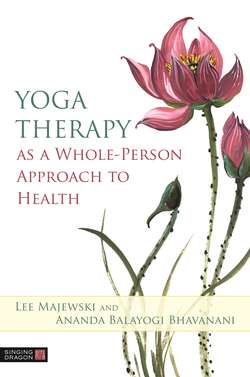Читать книгу Yoga Therapy as a Whole-Person Approach to Health - Lee Majewski - Страница 42
На сайте Литреса книга снята с продажи.
Contemporary trends and thoughts on the future
ОглавлениеThe limitation of modern medicine in managing stress-induced psychosomatic, chronic illnesses is the strength of yoga therapy. Hence a holistic integration of both systems enables the best quality of care for clients. It is imperative that advances in medicine include the holistic approach of yoga to face the current challenges in healthcare. The antiquity of yoga must be united with the innovations of modern medicine to improve quality of life throughout the world. This approach is becoming more acceptable with time, and a great proponent of such a method is Dr Dean Ornish, who has just published, with his wife Anne, UnDo It! How Simple Lifestyle Changes Can Reverse Most Chronic Diseases.25 They describe in detail lifestyle medicine that they have been practicing and researching for the last 40 years, which is based on such an integrated approach, and has successfully reversed cardiovascular disorders and other NCDs.
Lately, Dr Bhavanani has actually begun to question the very scientific research itself that makes up the foundation of “evidence-based” yoga therapy. Many excellent scientists are researching yoga and its effects on different populations and in different conditions, yet their understanding of yoga is too limited to produce meaningful results. This is because they try to fit the grand design of yoga into the limited box of scientific methodology, and end up not studying “yoga” at all. The research that is published is excellent from a scientific perspective, but truly very limited from a yogic perspective. We need to continue working on keeping the yoga in yoga therapy, and especially in yoga research, where it tends to get lost in the tight limitations of “standardization” and “study protocols.” Yoga therapy, by its definition, cannot be standardized or limited, as it is carefully crafted to the need of each client.
A brief qualitative survey on the utilization of yoga research resources by yoga teachers found a general lack of awareness of yoga research among practicing yoga teachers and therapists.26 Although a majority of respondents agreed that research was important, few were seriously updating themselves on such research findings through scientific channels. Most were updating themselves through general articles on the internet, and in most cases such information seemed to have minimal influence on their day-to-day teaching and practice.
At the individual level, when we acknowledge that yoga demands consciousness in every moment, we need to be living yoga in its highest and truest sense. Unless we live a life of yoga, or at least attempt to do so, how can we understand the inherent spirit of “wholeness” that joins all things together? Unless we lead by the example of our lives, how can we convince others to follow us? A good teacher teaches more by example than by words, and so does a good therapist, who heals more by “being” the therapy than by just assessing and prescribing techniques. The acquisition of a degree in yoga does not guarantee that the therapist will be a good yoga therapist. Conversely, someone’s lack of an academic qualification doesn’t mean that they will be a bad yoga therapist. Intelligence, empathy, compassion, and understanding are not necessarily by-products of an academic career or institutional status.
The need of the hour is for a symbiotic relationship between yoga and modern science. To satisfy this need, living human bridges combining the best of both worlds need to be cultivated. It is important that more dedicated scientists take up yoga and that more yogis study science, so that we can build a bridge between these two great evolutionary aspects of our civilization. Yoga is all about becoming “one” with an integrated state of being. Yogopathy, in contrast, is more about “doing” than “being.” When viewed from this holistic perspective, yoga can never really be an intervention, as this role must be left to yogopathy. We, as yoga practitioners, teachers, researchers, and therapists, must make a sincere and determined attempt to strengthen that one important link in the chain of yoga, the link of our personal, “every moment practice” (sadhana). This is imperative, for the very strength of the “chain of yoga” depends on it. We write about this further in Chapter 5.
